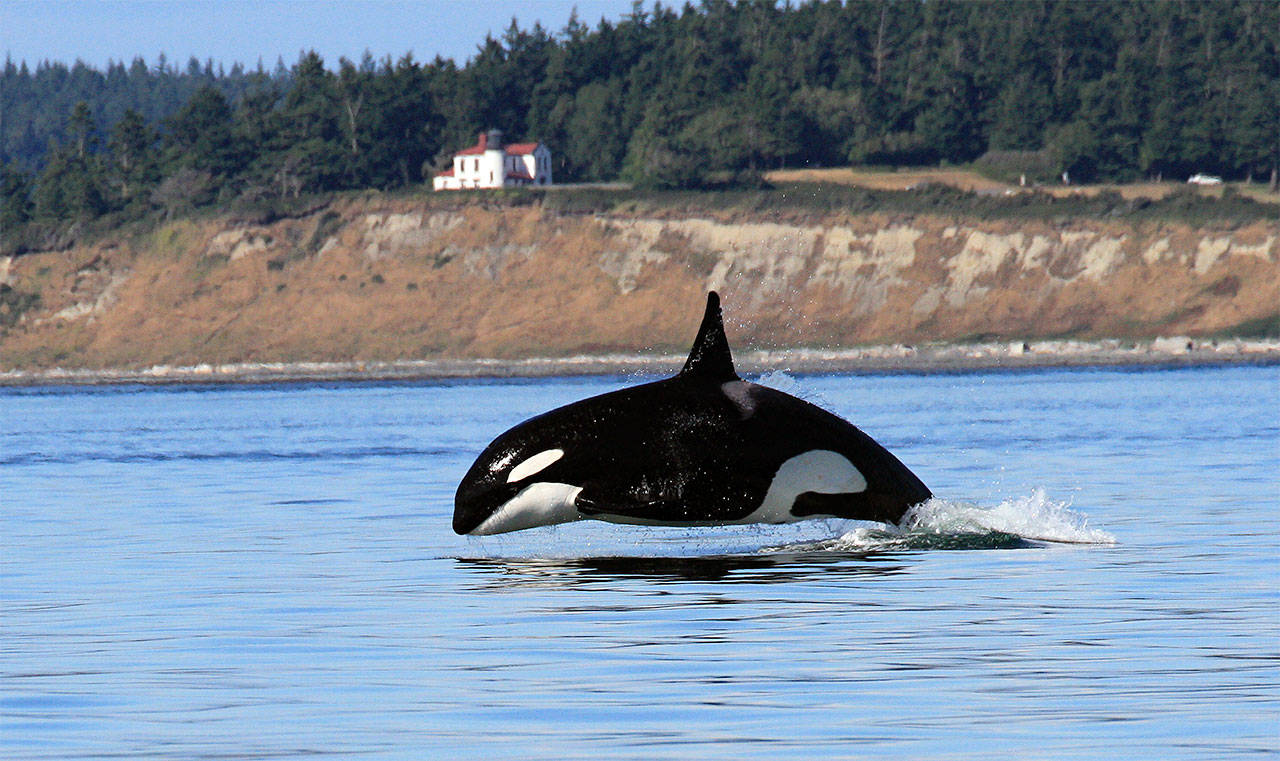The Southern Resident orcas are making their way back to the shores of Whidbey Island after a summer and early fall hiatus.
They’re going to be sticking around for a bit too.
The beloved whales that frequent Whidbey’s waters made 31 inland visits over the past three months — about twice more than their average number of visits in the fall and winter — and there’s a month or two left in the fall chum salmon season.
It came as a welcome relief to Susan Berta, co-founder of the Langley-based Orca Network, who expects they’ll continue making appearances this month and potentially into early February.
The uptick is in complete contrast to this summer and fall when sightings nose dived; the salmon stocks from Fraser River in British Columbia hit record lows for the J, K and L pods. With little food to bring them inland, the Southern Residents were spotted only 22 times from July to September compared to 62 sightings in 2016.
The increase and timing of the most recent sightings have some whale experts scratching their heads.
“It could be several things,” Berta said. “It’s always to do with the salmon. They are foraging, but we’ve heard mixed things.”
“My suspicion is that they’re finding more fish here than they are somewhere else. I have a feeling we’ll see them for sure through January,” she added.
The orcas typically begin visiting Puget Sound in early October after spending their summer near the San Juan and Canadian Gulf Islands in the Juan de Fuca and Georgia straits, respectively. The orcas feed on salmon through the fall and into the early winter months.
But, members of the Southern Residents’ L and J pods showed up about a week or two earlier than usual on Sept. 18 and Sept. 19. Sightings increased significantly in the following months. Their 11 visits in December alone were a surprise.
“We usually have maybe 14 or 15 the whole season — October through December and January,” Berta said.
Howard Garrett, co-founder of the Orca Network, said future sightings could fluctuate depending on their food supply.
“It may be over now,” Garrett said. “It all depends on the salmon runs.”
Garrett said the Southern Residents, which frequent the waters surrounding Whidbey Island, can feast on Chum, Chinook and Coho salmon if they can find the fish.
As promising as the sightings this fall and winter have been, the Southern Residents are still in a precarious position.
A multi-year study by the University of Washington, found at www.southwhidbeyrecord.com/news/uw-study-pins-orca-pregnancy-problems-on-lack-of-salmon, released in July linked a lack of salmon to failed pregnancies in Puget Sound’s Southern Resident orca pods. Two-thirds of pregnancies in the population failed from 2007 to 2014.
Their low reproductive success stemmed from stress of a low abundance in their most nutrient-rich food source, Chinook salmon.
In September, the Center for Whale Research announced the loss of calf J52, the first surviving offspring of J36. The news brought the critically endangered population down to 76, which is the lowest it’s been in over three decades according to a Orca Network press release.
Then on Oct. 15, the L54s, along with two adopted male orphans L84 and L88, were seen inland for the first time in 2017. That meant they spent zero time in their core summer habitat.
The population number, foraging spread, days of occurrence in the Salish Sea, body condition and live birth rate and neonate survival all indicated that the whales have limited food supply, according to Ken Balcomb, founder of the Center for Whale Research.
Efforts are being made to protect the orcas.
Gov. Jay Inslee answered a call by a collective of 16 conservation groups, including the Orca Network, to form an emergency task force to prevent the extinction of the Southern Residents and Chinook salmon.
The group, known as the Orca Salmon Alliance, is working to highlight the connection between the two endangered species and recover Chinook populations which the whales depend on for their survival, according its website.
There’s also going to be a chance to learn more about the current Southern Resident picture at a “Ways of Whales” workshop on Jan. 20 in Coupeville.
The Orca Network’s annual workshop is from 10 a.m. to 4:30 p.m. at the Coupeville Middle School Performing Arts Center on 501 S. Main Street in Coupeville.
It will cover everything from the endangered Southern Residents and their primary prey Chinook salmon to cetaceans such as blue and humpback whales.



